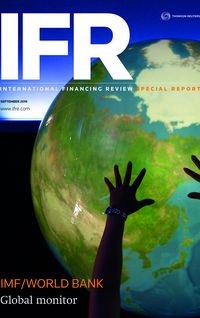Sovereign borrowing will continue to buoy loan market activity in the Middle East for years to come as Gulf states deal with the long-term effects of low oil prices, but immediate deal flow looks bleak.
Loan market activity in the Gulf over the last 12 months has been dominated by jumbo sovereign loans. Including loans to government related entities, they have bolstered deal volume to around US$80bn so far this year, compared to US$100bn for the whole of 2015, according to data from Thomson Reuters LPC.
In 2016, they include a US$10bn loan for The Kingdom of Saudi Arabia, a US$4bn five-year pre-export financing for Petroleum Development Oman (acting on behalf of the Sultanate of Oman) and a US$1.75bn three-year facility for Abu Dhabi’s Mubadala Development Company.
“The Gulf needs to get used to weak growth and as we look at things right now there will be big opportunities for debt raising. We have never seen so many sovereigns tapping the loan market as we have over the last 15 months” said one UAE-based head of loan syndicate.
At the annual Loan Market Association conference held in London on September 7, the audience was given the opportunity to vote on questions related to the market. Some 74% of respondents saw the Middle East as providing the best loan opportunities in the developing markets in the next 12 months.
Saudi Arabia was the most popular investment destination, receiving 36% of the vote, followed closely by the UAE at 31%. Oman took 9% of the votes, Bahrain 9% and Kuwait 7%.
The large vote for Saudi could well be influenced by the fact that the Kingdom was widely expected to tap the capital markets for a potential bond of up to US$15bn in September – one of a number of anticipated sovereign bond issuances. Kuwait and Bahrain are also rumoured to be coming to the market probably after Saudi has been placed.
This raft of sovereign bonds will result in a short term halt to Middle East loans, bankers said.
“There is a funding need but it is difficult to say where deals will come from. There was a very active August in the capital markets – people are taking advantage of the liquidity there,” said a UK-based head of syndicate.
Lending shift
The slowdown in loan activity has also been driven by a shift over the last 12 months from borrowers’ reliance on local bank funding back to international lenders, which had previously retreated from the region in 2008/09.
Local banks have become priced out of the market because of the increased cost of US dollar funding and the depletion of their balance sheets, as oil prices remain low and cash strapped sovereigns continue to withdraw of deposits.
“The investor base has changed – local banks are now excluded and international banks with lower funding costs are taking most of the debt themselves. This is mainly Asian banks, with the Japanese and now Chinese taking large slugs, followed by the French – a very different mix to what we saw a year ago,” said the UAE-based head of syndicate.
With a number of jumbo sovereign deals completed this year, these international lenders are close to their country limits.
“International banks’ capacity to lend is not endless,” said the UK head of syndicate.
Looking forward
While the fourth quarter is expected to be quiet for lenders, a pick-up is anticipated next year. The overall global low-deal environment means there will be lots of lending capacity for Middle East sovereigns looking to borrow as they grapple with budget deficits.
“I might not be optimistic about deal flow for the rest of this year, but just looking at what needs to happen in the Middle East, it is clear it is going to be busy over the next 12–24 months,” said the UAE syndicate head. “There are infrastructure projects and sovereign and FI refinancings which will need to be done.”
There is also a total of US$15.3bn of loans for Middle East borrowers maturing in 2017 that will need to be addressed, according to LPC data.
These include a number of short-term loans for bank borrowers, such as the US$575m two-year deal for Qatar’s Doha Bank and a US$175m two-year facility for UAE’s Al Hilal Bank.
“There will be a lot of FI refinancings next year and some new money loans,” said a third loans banker.
A number of larger deals, such as the US$1bn loans for Oman Oil Refinery and UAE’s Dubai Ports World, are also maturing in 2017. Bankers say the right assets in the right country will attract a lot of liquidity.
“Pricing may be going up across the region and liquidity has got tighter, but the situation does not affect all borrowers equally. Attractive defensive sectors with a sovereign link still have impressive pulling power – Saudi Arabia stands out in the crowd,” a fourth loans banker said.
Infrastructure deals will also provide important lending opportunities. Aluminium Bahrain’s latest infrastructure project has received financial commitments totalling US$1.5bn from banks to finance its Line 6 expansion project, double its initial target.
Alba plans to become the world’s largest single aluminium smelter complex, boosting its annual output by 540,000 tonnes to 1.5m tonnes, by adding a sixth “potline” used to produce the metal from raw materials such as bauxite.
Historically, many of these projects would have been funded by the sovereign. But with coffers under pressure, they now have to rely more on bank debt.
“There is a lot of infrastructure stuff out there, including power projects, that many of the sovereigns can no longer fund themselves, so if the budget deficit problem continues they will have to borrow,” the third banker said.
This situation has been exacerbated by the fact that many sovereigns have not curtailed their expenses – there has been no austerity along the lines of that seen in Europe, bankers said.
To see the digital version of this special report, please click here
To purchase printed copies or a PDF of this report, please email gloria.balbastro@tr.com



